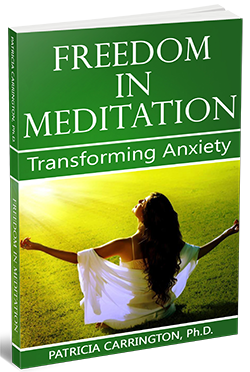 Meditation and Personal Growth
Meditation and Personal Growth
Patricia Carrington, Ph.D.
Author of “Freedom in Meditation”
At certain times, meditators may experience a string of memories drifting through their minds during meditation. Sometimes these are scenes of tranquil, nostalgic places from childhood, carrying with them a strong sense of pleasure. At other times disturbing images may arise.
These usually tend to lose their painfulness as the meditation continues, changing under the soothing rhythm of the mantra or the peacefulness of one’s own breath quietly attended to, or just dissolving in the stillness.
Memories that emerge during meditation are often sensed as unusually vivid; it may seem to the meditator as though he or she is reliving an experience rather than remembering it. Meditators can almost smell the scents, taste the food, feel the touch on their skin, see the remote details of the scene involved – details they may not have previously recalled since the original event. These kinds of reliving do not seem to be stories with plots and do not have the structure of dreams. They are vivid impressions.
However, similar to the greater ability to accept emotions calmly when in meditation is the dramatic lifting of repression, which sometimes occurs in meditators, permitting long-buried memories to come to the surface. One of the most impressive effects of meditation I have seen involved release of forgotten, terrifying memories in a woman who had for many years effectively banished them from her awareness.
Adele initially came to the guidance clinic for help for her young daughter, who was suffering from severe anxieties which hampered her at school, but she denied the need for any psychotherapy for herself although she was obviously tense. Her voice was high-pitched, her breathing rapid, her speech pressured. She had a chronic heart condition for which she took medication several times a day and she suffered from high blood pressure and a thyroid condition. Soon after her daughter began to be seen for psychiatric treatment, Adele complained that she was unable to cope with the child and entered a mothers’ guidance group which I was leading.
When she joined our group she was fearful about whether or not she would ‘fit in’ with the other mothers, and it seemed at first as though she was trying too hard to be liked by them. Because she was so tense, I decided that meditation might be a useful aid to her treatment.
When Adele learned Clinically Standardized Meditation (CSM), her immediate response was a powerful one. She reported that during her first meditation she had felt as though she were a bird gliding freely through the skies, experiencing a wonderful sense of freedom as she drifted over the countryside. During this first meditation, too, she spontaneously shifted from using the mantra which she had chosen from the list of CSM mantras, and substituted for it a phrase of her own which suddenly popped into her mind – ‘inner peace’. She continued to use this self-made mantra from then on and found it a most effective calming device.
Some effects of meditation on Adele’s life were almost immediate. Within two days of commencing this practice, her heart became slow and regular and she was able to dispense with her heart medication within the first week of learning to meditate and has never returned to it.
During the first few weeks, her meditations involved images of floating and drifting in the sky among nature, flowers and other peaceful symbols. Soon, however, these pleasant ‘floating’ sensations began to alternate with frightening ones in which she would see atomic explosions or other cataclysmic happenings during her meditation. At this time Adele requested an individual psychotherapy session with me.
Because she seemed unusually tense, I suggested that she and I meditate together before commencing her therapy session. We had been meditating for about ten minutes when the session was interrupted by loud, almost hysterical laughter. Adele explained that she had had a sudden fantasy during meditation: she had imagined she was on a boat with her mother and she had pushed her mother off into the water. It had given her so much pleasure that she could not restrain herself from bursting out laughing.
She confided in me that this fantasy was an ‘incredible thought’ for her and wanted to know if it were ‘normal’ for her to have such thoughts. When I assured her it was normal to have many mixed feelings about a parent, a floodgate opened.
Up until this point she had insisted that her parents were ‘fine and wonderful people – no one could ask for better’. Now she revealed that she had been a battered child living in terror of a psychotic mother. One memory after another came to the surface in this session, some of them memories which she had managed to push out of her mind since childhood.
Adele had been born without the sanction of the church of which her mother had been a devout member. Because of this, Adele’s mother viewed her daughter as having been born ‘in sin’ and developed a mental illness shortly after the child’s birth which lasted during the girl’s entire childhood.
The first buried memory to surface during a meditation session was an early childhood incident that Adele had long tried to forget. When Adele was three years of age, in a fit of rage, her mother had grabbed a dish towel, twisted it around the child’s neck, and tried to strangle her. It was only when a neighbor across the alleyway, seeing this attack through the window, rushed to the door to intervene, that her mother, in a daze, had let go.
Another meditation session brought to light a different incident which Adele had not recalled for almost thirty years. When she was very young, her father had given her a toy dog as a gift before leaving on one of his all too frequent business trips. She had carried this toy about constantly when he was away and, perhaps because of its comforting presence, cried out, ‘I’ll tell Daddy!’ the next time her mother started chasing her in order to catch her and beat her. In retaliation for Adele’s ‘answering back’, the mother had dragged her into the cellar of their home, locked the door, and told Adele that if she ever revealed to anyone, especially her father, the mother’s beatings, she would push her into the furnace. To illustrate this point, she threw the toy dog into the furnace and forced Adele to watch it burn.
Despite the intense difficulties in her life, Adele had managed to save herself from destruction, as soon as she graduated from effective methods of self-defense such as karate and judo. She did learn how to defend herself, and later worked, married, had several children, and lived a generally constructive life, although her many tension-related illnesses attested to the fact that her traumatic early life was still having its effect on her.
As she began to discuss her mother’s mistreatment of her in individual psychotherapy, her meditations became filled with hostile fantasies toward her mother. At one point she vividly pictured an atomic bomb killing her parents but sparing the rest of the population. So many painful memories were beginning to surface during her meditation sessions, in fact, that Adele began to be afraid of meditating, while at the same time she did not want to stop because it was obviously benefiting her heart condition. At this point I advised her to reduce her meditation time to three to five minutes per session to slow up the tension release. This worked well and Adele was soon ready to share her painful memories with the mothers’ group in which she participated.
This was an important step. Her mother’s childhood threats about the terrible punishments that would follow if she told anyone about her mother’s mistreatment were still deeply ingrained in her. When the other women in the group accepted her painful revelations with understanding and support, it was a source of new strength for her. Following this, her attitude toward her own mother began to change. She was now able to accept the fact that her mother had been mentally ill and probably should have been hospitalized during those years – that, in effect, she had not been responsible for her actions. This realization so relieved Adele that she was able to return to meditating for a full twenty minutes twice a day, a schedule she has been able to maintain ever since. Memories now stopped flooding her meditation sessions which were once more filled with largely pleasant fantasies, with only occasionally a momentary violent scene.
From then on Adele found herself less harassed about many things. When her children started yelling at each other around the house, it no longer upset her. Her compulsive nail-biting stopped. Life-long nightmares receded to almost zero. It was also instructive to see her lose her need to prove to the world that she was ‘self-sacrificing’. She was now easy-going and casual in the mothers’ group and had stopped trying to solve everyone else’s problems for them. As she worked through her painful relationship with her own mother, she also found herself able to play with her little daughter for the first time, and to thoroughly enjoy doing so.
Adele says that if she had not had individual psychotherapy sessions along with meditation, she would have been so frightened by the upsurge of painful memories that she would not have been able to continue meditating. I agree that had she not had my support and later the encouragement of the group to help her handle her anger at her mother, she almost certainly would have had to discontinue meditation in order to escape unbearable anxiety. I doubt, however, whether psychotherapy alone could have helped Adele resolve these problems. She was initially too fearful of facing the painful areas in her life to have allowed herself to enter individual psychotherapy of the type where free association might have been used to recover repressed memories. Meditation, however, enabled these memories to surface within a remarkably short span of time so they could be constructively dealt with in her therapy.
Related Product:
 Clinically Standardized Meditation (CSM) is a clinically sensitive meditation method used by numerous medical institutions, organizations, and individuals worldwide. The main advantages of CSM (and also its difference to other forms of techniques of meditation) are its simplicity, its flexibility and its sensitivity to the individual needs and inclinations of the people who learn it. CSM is extremely permissive, which makes it easier to personalize and internalize the technique and its experience.
Clinically Standardized Meditation (CSM) is a clinically sensitive meditation method used by numerous medical institutions, organizations, and individuals worldwide. The main advantages of CSM (and also its difference to other forms of techniques of meditation) are its simplicity, its flexibility and its sensitivity to the individual needs and inclinations of the people who learn it. CSM is extremely permissive, which makes it easier to personalize and internalize the technique and its experience.







